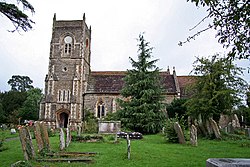Slinfold
| Slinfold | |
| Sussex | |
|---|---|
 St. Peter's parish church | |
| Location | |
| Grid reference: | TQ119311 |
| Location: | 51°4’7"N, 0°24’12"W |
| Data | |
| Population: | 1,647 (2011) |
| Post town: | Horsham |
| Postcode: | RH13 |
| Dialling code: | 01403 |
| Local Government | |
| Council: | Horsham |
| Parliamentary constituency: |
Horsham |
| Website: | Slinfold Parish Council |
Slinfold is a village in the north of Sussex, four miles west of Horsham, just off the A29 road.
The Census recorded a parish population of 1,647 in 627 households.
Slinfold is the source of the River Adur, a river that cuts through most of the width of Sussex to enter the English Channel at Shoreham-by-Sea[1]
The village has a village shop and Post Office, a primary school and pre-school, a recreation ground, a village hall and one public house, the Red Lyon. Where Slinfold Railway station used to be is now a Caravan Club site.
Contents
History
Romans
Alfoldean in Slinfold was the subject of a dig by archaeological television programme Time Team in 2006,[2] the site of one of a probable four mansiones on the route of Stane Street between London and Chichester.[3]
Manors
There has been a house at Dedisham, a mile north-east of the village, since at least 1271, when Henry III granted the then occupier a licence to crenellate the manor house then on the site.[4] The present house on the site appears to date from the 16th or 17th century.[4] During the Civil War the Parliamentarian commander Sir William Waller sacked a house on this site in 1643.[4]
Slinfold Manor, a mile and a half south of the village, is a Georgian house built late in the 18th century.[4]
Economic and social history
Slinfold railway station on the Cranleigh Line was opened in 1865 and closed in 1965. The trackbed of the line now forms part of the Downs Link Bridleway. The route of the former Roman road linking London and Chichester passes through the parish [5] and a Roman posting station existed at Alfoldean. In 1848 it was recorded that Roman swords and brass ornaments had been found in the parish.[5]
Churches
- Church of England: St Peter's
- United Reformed Church: Slinfold Chapel
The parish church, St Peter, was designed by the Gothic Revival architect Benjamin Ferrey in a late 13th-century style and built in 1861 on the site of the original mediæval parish church.[6]
Bell legend
It is said that there is a boggy hollow near Slinfold which contains a sunken bell. Long ago some villagers, hoping to retrieve the bell, sought the advice of a witch. She told them that it could only be retrieved by 12 white oxen, at midnight. The oxen were used, but one villager broke the witch's instructions by speaking, and the bell sank back into the bog.[7]
Outside links
| ("Wikimedia Commons" has material about Slinfold) |
References
- ↑ "River Adur". Waterscape. British Waterways. http://www.waterscape.com/canals-and-rivers/river-adur.
- ↑ "Alfoldean, Slinfold: Archaeological Evaluation and Assessment of Results". Wessex Archaeology. April 2006. https://www.wessexarch.co.uk/sites/default/files/59473_Alfoldean%20Horsham.pdf.
- ↑ National Heritage List 1005838: Alfoldean Roman site (Scheduled ancient monument entry)
- ↑ 4.0 4.1 4.2 4.3 Nairn & Pevsner 1965, p. 329.
- ↑ 5.0 5.1 Lewis 1848, pp. 120–123.
- ↑ Nairn & Pevsner 1965, p. 328.
- ↑ Ash, Russell (1973). Folklore, Myths and Legends of Britain. Reader's Digest Association Limited. p. 208. ISBN 9780340165973.
- Lewis, Samuel: 'A Topographical Dictionary of England' (S. Lewis and Co., 1848) pp120–123 ISBN 978-0-8063-1508-9
- Nikolaus Pevsner: The Buildings of England: Sussex, 1965 Penguin Books ISBN 978-0-300-09677-4